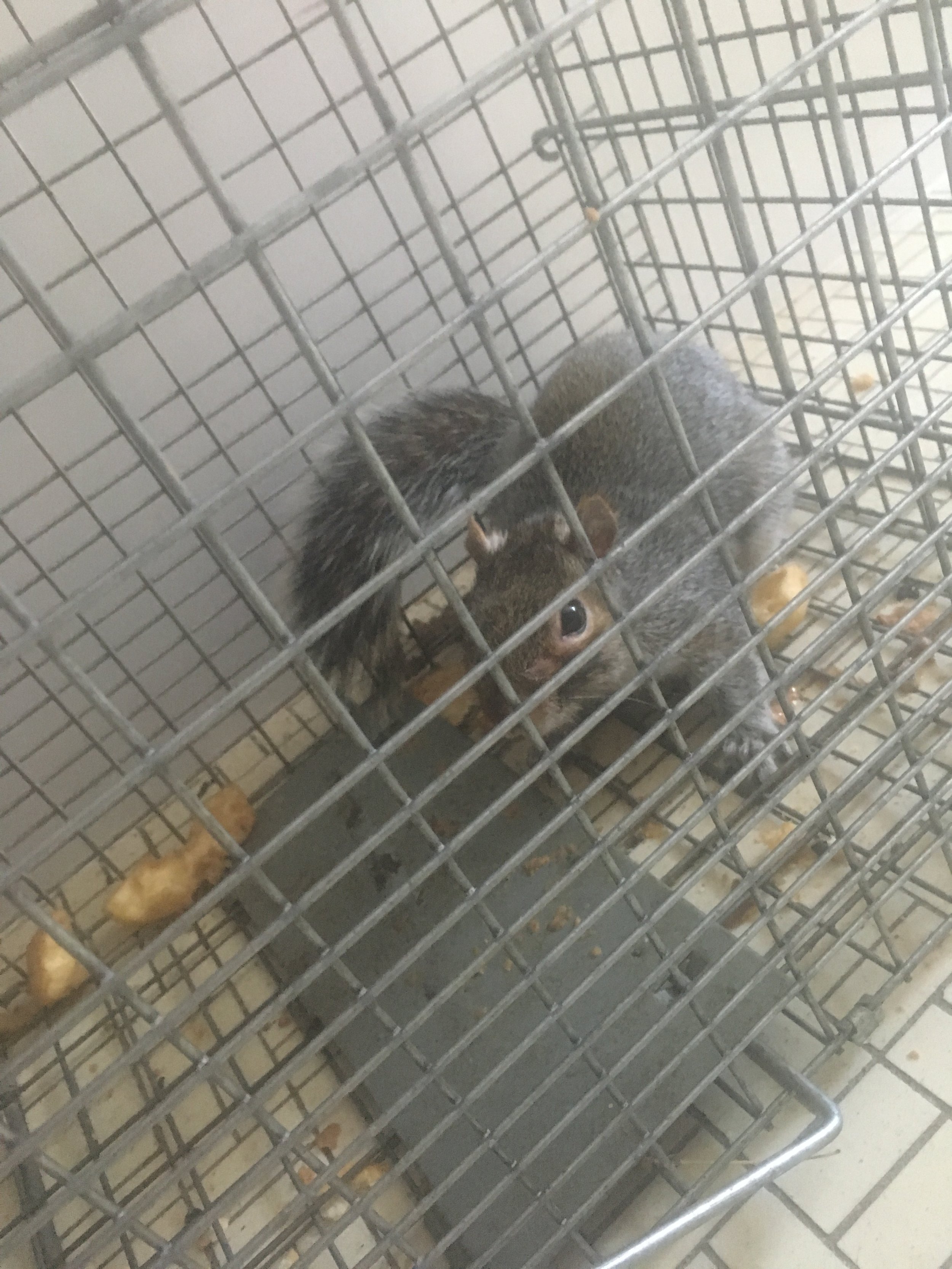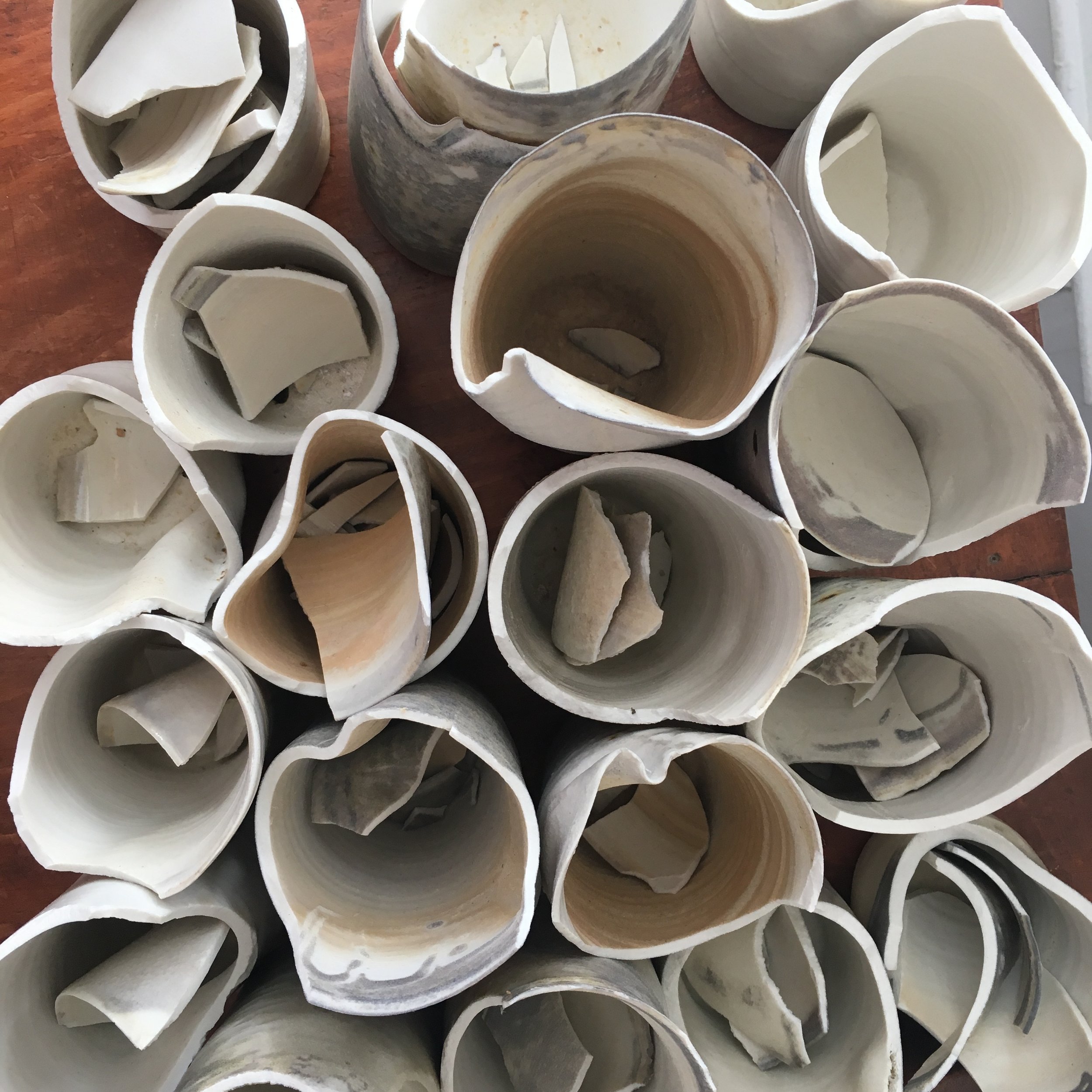"If you have come here to help me, you are wasting your time. If you have come because your liberation is bound up with mine, then let us work together." -Aboriginal activist Lilla Watson
On my dining room side-table is a sharp landscape of cracked cups, the result of a squirrel break-in Christmas week. As he struggled to escape my cat, the squirrel scaled the windowsills knocking down several dozen of my favorite wood-fired vessels for my project Each Day, Water. The squirrel did escape with his life. And in the after-math was the silence of porcelain rubble and shards. I spent an entire night sorting the little broken pieces, which now nestle inside the jagged hollows of their parents. On their way to me in the mail from Japan are special resins and precious metal powders. I will make kintsugi (literally, “golden rejoining”) of some of these vessels. The aesthetic power of kintsugi relies upon the fact that there is more beauty when we can perceive the patterns of separation and breakage (fragility) intrinsic to the material of which something is made. I am aware of the significance of taking this medieval wabi-sabi Japanese art process and applying it to a project about indigenous peoples' rights, broken Treaties, and a Native-led environmental and spiritual movement, and part of me thinks: not only am I mixing my metaphors, I am walking on thin ice regarding cultural appropriation. Not only do I not want to appropriate a Native struggle and Movement as my own, but now, something from Japanese culture too?
And then I think: I could just stop there. Let be. Avoid these risks. Yet I can't. My consciousness is wrapped up in all of this. Kintsugi used to happen only in Japan but now it is commonplace; you can order supplies with a credit card and learn it on the internet. There are upcoming workshops in Sarasota, FL. I learned a bit about it last year at my clay studio (with proxy materials); enough to repair a lidded jar. This is America, the kaleidoscope: turn it, and the context changes; what used to be over there is now in a new place, in a new relationship. For better and for worse, using kintsugi for Each Day, Water is both out-of-context and in-context in our polyglot and scarred society. An aesthetic mode can evoke a real problem, however, it can also dangerously aestheticize it and anesthetize us to its gravity.
Significantly – I recall the seams of gold and other precious metals inside the Black Hills (Ke’ Sapa) of South Dakota/ Wyoming: the origin-place of the people of Oceti Sakowin (the Seven Councils of the Great Sioux Nation). Those very seams of precious metals are what drove the 19th-century colonial conquest of the Black Hills, and the disregard since for their primary and sacred value to the Sioux people. Among the scores of broken Treaties is the way the U.S. Federal government has dealt with the Sioux over the issue of land "ownership" of the Black Hills, who by Treaty rights claim this land as their sovereign territory. Despite the Treaty, the Black Hills Land Claim dispute continues.
So, is it cultural appropriation for me to make art about such broken Treaties, such as the Treaty of Fort Laramie (1868), and the Native-led Water Protector movement? My answer: maybe, but I really hope not. I guess it is a risk I am taking because my heart has been unrelentingly wrapped up in the profundity of the indigenous struggle for environmental justice, and in appreciating the resilience and power of indigenous communities, since I saw the raw, shocking footage from Standing Rock and have done my best to learn and be informed since about instances of abuse toward indigenous communities worldwide. In this country, the broken Treaties are as a much a "colonizer" problem as they are a Native issue as they describe a relationship problem, in which those holding legislative power (the colonizers) have clearly been abusive, and the general population of this country has not expressed enough concern and outrage over this to stop or reverse explicitly exploitative, greedy, racist policies. The Water Protector movement is indigenous-led, and it has galvanized solidarity and gathered ally-participants worldwide. The "environmental movement" is perhaps closer to my cultural inheritance, but the reason I'm not making this art piece about that movement is because 1. Science has enough defenders and advocates within my culture, and ceremony rooted in a sense of the sacredness of the earth does not and 2. Groups of "cultural mainstream" environmental/ activists are not (yet) getting shot at with chemical-laced water cannons in below-freezing weather, shot at with rubber bullets, physically dragged and beaten, sprayed with teargas, arrested, locked up in dog cages, and legally prosecuted as they conduct their work and campaigns. 3. These extreme measures taken by the industrial-military-legal complex to suppress the Water Protectors speak volumes about the critical importance of their protest. 4. Activists in the mainstream environmental movement have a lot to learn from the example set by how the Water Protectors of Standing Rock organized and conducted themselves under the harshest of conditions. 5. Environmental as well as other forms of systemic racism must end. Racism flourishes in conditions of separation, segregation, and ignorance. I make this work to try to help counter these separating forces, and further develop the existing alliances between non-Natives and Natives resisting further destruction of the earth, as well as further destruction of good will existing between our respective communities.
But it would be inappropriate if I frame myself as a hero; anti-racist work by people like me who have benefited from "white privilege" is not heroic, but it is necessary. It would also be wrong if I did not invite involvement of indigenous Water Protectors in the process of developing and presenting this project, that those interested and willing might offer. Yet making requests of an already-stressed group is suspect. I go forward, knowing that I might be ignored for any number of valid reasons, but hoping to find connections with Water Protectors who might find connection with the creative projects I'm doing, and who might want to talk with me or contribute in some way. I am working as an ally to Water Protectors, to raise awareness of what I perceive, since Standing Rock, to be one of the most crucial issues of our current society. A current problem, grounded in centuries of prior cruelty. Is it appropriate for me to do so? I hope so. Is it appropriation? I hope not. As I ask Water Protectors how they feel about my efforts, I generally get a positive feeling, but I intend to keep deepening this dialogue. To act as an ally in the specific struggle of the Water Protectors is a chance to do something right where there has been wrong after wrong after wrong.
The pipelines that transport fracked oil and gas that have been (and are being) constructed all across our country pose a real threat not only to Native communities but to all of us. In this context, the sentiment expressed above by Lilla Watson rings clear and true. How free will any of us be within a carbon-baked world and without certain access to clean water? In this sense, the indigenous people occupying "reserve" lands crossed by or proximal to pipelines (or uranium mining sites, and so on) are the canaries in the coal mine. And it should not be denied that this is an utterly unfair role to play, particularly on sovereign Tribal lands. Yet communities of indigenous people have been in this position for far too long. It is environmental racism when people of a racial/ ethnic/ cultural group are forced to live, against their will and not due to their own influence, under toxic conditions. These conditions are then either kept invisible (or obfuscated in some way) and/ or responsibility is shirked by those who created them. Before they were even called this name, indigenous Water Protectors have both endured and fought against such toxic conditions for decades. These seem (in part, if not fully) like strategic, sinister acts of destruction. Sadly, there is nothing new about that in our settler-colonial society. It is also disheartening that the current surge in the fossil fuel industry rolls back progress and protections on so many levels, and with reckless abandon that gravely threatens us all. As fossil fuel extraction and infrastructure projects expand, the scope of contamination and warming effects do too, and no one is immune.
As an artist, one necessarily draws some attention to oneself as a creator, but hopefully the work I am doing shines the brighter star on the heroes it aims to recognize and support: the Water Protectors who risk life and limb to make their stand in direct action against these infrastructures. I want them, their courage, and their fight against nearly impossible odds to be honored. I feel torn about the indirectness of art, of metaphor, as a form of action. Yet for now, this is what I do. All of our freedoms are bound up in this struggle, including the rare breathing room of art-making, the creative process. Mni Wiconi. Water is Life. My project won’t be perfect. My relationships with Water Protectors are still newly forming. I'll make mistakes. I already have. I try to learn from them. There is geographical distance and there are other, deeper forces of separation at work too. I only hope the Water Protectors will feel celebrated, honored by my efforts. The little squirrel brought me a gift by breaking some of these cups. I hope restoring what has been broken will not just happen in artistic expression, but in truth and lived reality. Through seeing the seams we may be reminded of our shared vulnerability, and the necessity of ongoing acts of repair.

